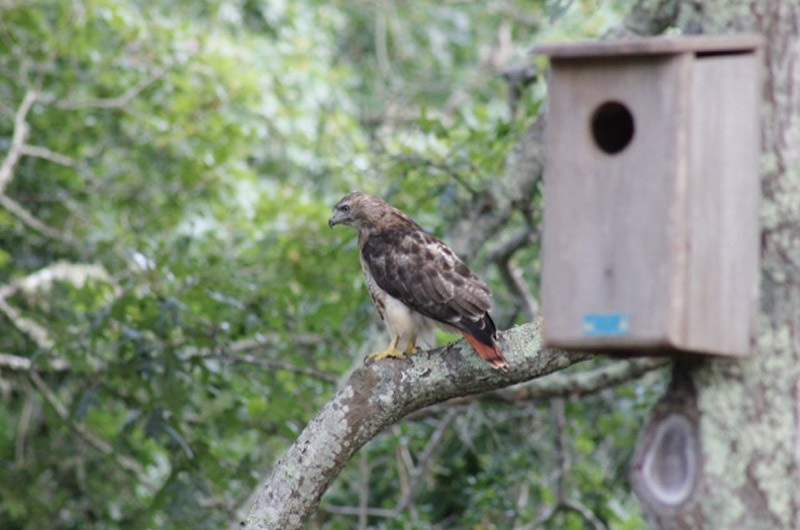This week's All Outdoors column is about how drought this year has greatly reduced the growth of oaks that have invaded meadows. A fall mowing regimen can be beneficial as it prevents the oaks from growing into trees. Oaks and pines that are mowed in the fall will not grow so much in one season that they become too tall to mow again the following year. And fall mowing also encourages the spread of butterfly weed, milkweed and other fall-seeding plants. Their seeds are planted in the thatch from the mowing.
But fall mowing can be detrimental because it produces a barren habitat for late-fall and winter resident birds as there is no cover to protect them from predators. This practice is one of the many factors contributing to the current scarcity of bobwhite quail, ring-necked pheasants, meadowlarks and other grassland birds. It also reduces the foraging habitats for our fall migrant and winter resident sparrows and any other seed-eating species. They are much less likely to forage in the middle of a mowed meadow because there is no nearby cover for them to hide in when the inevitable predator suddenly approaches.
There are alternative management strategies that avoid such a lengthy and artificially barren habitat. One of them is to mow in early spring, when the growing season starts. This strategy shortens the time when there is barren habitat to a month or less, depending on how quickly the mowed vegetation starts growing.
Another strategy is to remove the offending oaks completely, creating a meadow that may not need to be mowed at all. Cutting down the trees and then grinding out the root crowns will kill the trees. Or, an herbicide can be applied to the very recently cut stump, which will kill the tree by poisoning its roots. This latter technique is most effective in the fall, when the trees are transporting sugars and water from their leaves to their roots. Both techniques remove offending oaks without altering the grasses and shrubs that provide cover and protection from predators.
Yet another strategy is to utilize spring-time controlled burns to remove the offending oaks. This will likely require a longer time frame as multiple burns will be necessary to remove the oaks. But controlled burns may not be politically realistic in many of our oak-infested meadows.
Herbivory is yet another option. Goats are known to graze on oaks and woody invasive species like Oriental bittersweet, and they are not left in one area long enough to overgraze the area into a barren habitat. However this will take time, as multiple visits from the goats are needed to control the woody vegetation.
So there are many options that will prevent half a year of barren habitat in these oak-infested meadows. Careful decisions are necessary to manage land to protect all of our natural resources.
Bird Sightings
The Wilson’s phalarope reported last week was still at Little Black Point Pond as of August 4. Ken Magnuson filmed it as it did the phalarope thing — swimming in tight circles to bring food to the surface.
Warren Woessner scoped the mudflats at the western end of Norton Pont on August 5 and found one white-rumped sandpiper. This seems a bit early for this species as they usually do not show up until mid-August. Otherwise, the usual shorebirds were still there — greater yellowlegs, American oystercatcher, semipalmated sandpiper, least sandpiper, sanderling, short-billed dowitcher, black-bellied plover and semipalmated plover.

Ken Magnuson and Kelly Spenser were also there and added black terns and laughing gulls to the list. And at the same location on August 7, Mr. Woessner found two adult gull-billed terns and watched them pick edible morsels off the water as they made slow swoopy dives. Later that day, Lanny McDowell found five pairs of black skimmers, an unexpectedly high number given that this species did not nest there this year.
In addition to some of the above species, Stephen Carey adds willets, a green heron and ruddy turnstones at State Beach on August 5. And he found 11 great egrets at Lobsterville on August 6.
Mr. Woessner also reports that he finally heard his first Carolina wren of the year, at Island Tire on August 5. So too did Robin Bray hear and observe her first one of the year, in her yard on August 9. These wrens are recovering from last winter slowly but surely, one or two fledglings at a time.
Steve Allen’s highlights from Felix Neck on August 6-7 are green heron, hairy woodpecker and cedar waxwing.
John Banks reports finding a snowy egret at Sarson’s Island on August 5.
Lanny McDowell observed an adult brown thrasher teaching a youngster about dust bathing in the middle of Pete Gilmore’s driveway on August 7.
Mark Mattson reports two belted kingfishers are present morning and evening at his pond in Aquinnah. Sometimes there are also black-crowned night-herons and green herons at the pond.
Phil Edmundson reports all the usual shorebirds plus a spotted sandpiper at Tisbury Great Pond on August 9.
An adult red-tailed hawk has returned to Rob and Paula Evans’s yard on August 9, after an absence of several weeks. Their grandchildren, Charlotte and Will Evans, were the first to spot the returning raptor.
Nora Papian found a sanderling at Quansoo Beach on August 10 that had a green flag with “Y4P” written on it on its left leg. That information was enough to determine that the bird had been banded on May 13, 2014 in Delaware.
There are lots of birds around, so please get out looking for them, and be sure to report your bird sightings to birds@mvgazette.com.
Robert Culbert leads Saturday morning guided birding tours and is an ecological consultant living in Vineyard Haven.




Comments
Comment policy »